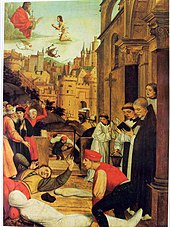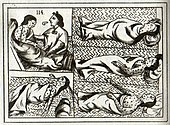List of epidemics
This article is a list of major pandemics and epidemics caused by infectious diseases in human history. Events in boldface are ongoing.
| Rank | Epidemics/pandemics | Date | First outbreak | Location | Death toll |
|---|---|---|---|---|---|
| 1 |  Black Death |
1346–1353 | Xi'an, China | Europe, Asia and North Africa | 75–200 million |
| 2 |  Spanish flu |
1918–1920 | Manhattan, Kansas, USA | Worldwide | 17–100 million |
| 3 |  Plague of Justinian |
541–542 | Pelusium, Egypt | Europe and West Asia | 15–100 million |
| 4 | HIV/AIDS pandemic | 1981–present | East Africa | Worldwide | 43 million+ (2024) |
| 5 |  Third plague pandemic |
1855–1960 | Yunnan, China | Worldwide | 12–15 million |
| 6 |  Cocoliztli Epidemic of 1545–1548 |
1545–1548 | Mexico | North America | 5–15 million |
| 7 |  Antonine Plague |
165–180 | Seleucia, Iraq | Roman Empire | 5–10 million |
| 8 |  1520 Mexico smallpox epidemic |
1519–1520 | Mexico | North America | 5–8 million |
| 9 |  COVID-19 pandemic |
2019–present | Wuhan, China | Worldwide | 7-35 million (as of 2024) |
| 10 |  Asian flu |
1957–1958 | Guizhou, China | Worldwide | 1–4 million |
| Hong Kong flu | 1968–1969 | Hong Kong | Worldwide | ||
| 11 | 1918–1922 Russia typhus epidemic | 1918–1922 | Russia | Siberia | 2–3 million |
| 14 | 735–737 Japanese smallpox epidemic | 735–737 | Dazaifu, Fukuoka | Japan | 2 million |
| 1772–1773 Persian Plague | 1772–1773 | Baghdad, Iraq | Persia | 2 million | |
| 16 |  Naples Plague |
1656–1658 | Naples, Italy | Europe | 1.25 million |
| 17 |  Third cholera pandemic |
1846–1860 | Mecca, Saudi Arabia | Worldwide | 1 million+ |
| 18 |  1629–1631 Italian plague |
1629–1631 | Milan, Italy | Europe | 1 million |
 1889–1890 flu pandemic |
1889–1890 | Bukhara, Russia | Worldwide | 1 million |
Worldwide Pandemics[change | change source]
- 1194-1184 BCE: influenza: Trojan War epidemic[1]
- 713 BCE: influenza: Assyrian epidemic[1]
- 430-425 BCE: influenza (?): Plague of Athens[1]
- 165-180: Antonine Plague, perhaps smallpox
- 541: the Plague of Justinian[2]
- 591-592: influenza: Extreme Cough[1]
- 1300-50s: The Black Death in Europe and Asia during the Late Middle Age (Killed 60% of the population) [3]
- 1501-1587: typhus[4]
- 1729: influenza[5]
- 1732-1733: influenza[5]
- 1775-1776: influenza[1]
- 1781: influenza[5]
- 1816-1826: cholera[6]
- 1829-1851: cholera[6]
- 1830: influenza[5]
- 1847-1848: influenza
- 1852-1860: cholera[6]
- 1855-1950s: bubonic plague: Third Pandemic in China and India
- 1857-1859: influenza
- 1870-1874: smallpox[7]
- 1863-1875: cholera[6]
- 1881-1893: cholera[6]
- 1889-1892: influenza[5]
- 1899-1923: cholera[6]
- 1918-1920: avian flu: Spanish flu: more people were hospitalized in World War I from this epidemic than wounds. Estimates of the dead range from 20 to 40 million worldwide (WHO)[8]
- 1957-1958: influenza: avian flu: Asian flu[5]
- 1961-present: cholera called El Tor[6]
- 1981-present: HIV/AIDS (As of 2018, more than 32 million have died from AIDS) [9]
- 1968-1969: influenza: avian flu: Hong Kong flu[5]
- 2002-2003: SARS[10]
- 2009-2010: 2009 flu pandemic (swine flu) [11]
- 2019 to present: COVID-19 pandemic (Ongoing pandemic)[12][13]
Regional[change | change source]
Asia[change | change source]
- 165: Antonine Plague - Seleucia, Iraq
- 541: Plague of Justinian - Pelusium, Egypt
- 735: 735–737 Japanese smallpox epidemic - Dazaifu, Fukuoka, Japan
- 1772: 1772–1773 Persian Plague - Baghdad, Iraq
- 1826: 1826–1837 cholera pandemic - Ganges, India
- 1846: Third cholera pandemic - Mecca, Saudi Arabia
- 1855: Third plague pandemic - Yunnan, China
- 1889: 1889-1890 pandemic - Bukhara, Russia
- 1890: Russian flu - Hohhot, Inner Mongolia, China
- 1918: 1918–1922 Russia typhus epidemic - Siberia, Russia
- 1957: 1957-1958 influenza pandemic - Guizhou, China
- 1968: Hong Kong flu - Hong Kong, China
- 1997: Avian flu - Hong Kong, China
- 2002: SARS - Foshan, Guangdong, China
- 2003: Avian influenza epidemic - Fujian, China
- 2012: 2012 MERS epidemic - Jeddah, Saudi Arabia
- 2015: 2015 South Korea MERS epidemic - Jeddah, Saudi Arabia
- 2019: 2019 Philippines measles outbreak - Manila, Philippines
- 2019-present: COVID-19 - Wuhan, Hubei, China
- 2019: 2019–20 Brucellosis outbreak - Lanzhou, Gansu, China
- 2020: 2020 Hantavirus outbreak - Luxi, Yunnan, China
- 2020: 2020 G4 EA H1N1 outbreak - Hebei, China
- 2020: 2020 Inner Mongolia bubonic outbreak - Bayannur, Inner Mongolia
- 2020: SFTS bunyavirus outbreak - Jiangsu, China
- 2020: 2020 Idiophatic outbreak - Eluru, India
- 2021: India fungus epidemic - New Delhi, India
- 2021: Hong Kong Streptococcus outbreak - Hong Kong
- 2021: Flurona - Petah Tikva, Israel
- 2022: 2022 Henan H3N8 outbreak - Zhumadian, Henan, China
- 2022: 2022 Langya virus outbreak in China - Shandong, China
- 2022: 2022 HFMD outbreak in the Philippines - San Pascual, Batangas
- 2023: 2023 North Korea respiratory disease outbreak - Pyongyang, North Korea
Central and South America[change | change source]
- 1493: influenza - Hispaniola
- 1518: smallpox - Hispaniola
- 1520: smallpox - Mexico
- 1527-1530: smallpox - Peru
- 1530-1531: measles - Mexico, Peru
- 1546: typhus - Mexico, Peru
- 1558-1559: influenza - Mexico, Peru
- early 1600s: malaria
- 1648: yellow fever
- 2009: 2009 swine flu pandemic - Veracruz, Mexico
Europe[change | change source]
- 415 BCE: Athenian army in Sicily[1]
- 393 BCE: Carthaginian siege of Syracuse[1]
- 1347-1351: Black Death - Xi'an, China
- 1582-1583: plague - San Cristóbal de La Laguna (Tenerife, Spain)
- 1629: 1629–1631 Italian plague - Milan, Italy
- 1613: diphtheria[14] - "El año de los Garotillos[15]"
- 1656: Naples Plague - Naples, Italy
- 1665-1666: Great Plague of London - London, UK
- 1720: Great Plague of Marseille - Marseille, France
- 1782: Influenza: Russian Katarrh[1]
Egypt & North Africa[change | change source]
- 212 BCE: Second Punic War epidemic[1]
- 1801: plague
- 1831: cholera
- 1834-1836: plague
- 1848, 1865, 1881: cholera
- 1902: cholera
- 1942-1944: falciparum malaria
- 1946: relapsing fever
- 1947: cholera
- 2022: 2022 monkeypox outbreak - Lagos, Nigeria
- 2022: 2022 Marburg virus disease outbreak in Ghana - Ashanti, Ghana
- 2022: 2022 Uganda Ebola outbreak - Mubende, Uganda
North America[change | change source]
- 1657: measles - Boston, Massachusetts[16]
- 1687: measles - Boston, Massachusetts[17]
- 1690: yellow fever - New York, New York[17]
- 1713: measles - Boston, Massachusetts[18]
- 1721-1722: smallpox - Boston, Massachusetts
- 1729: measles - Boston, Massachusetts[17]
- 1738: smallpox - South Carolina[17]
- 1739-1740: measles - Boston, Massachusetts[17]
- 1747: measles - Connecticut, New York, Pennsylvania, South Carolina[17]
- 1759: measles - North America[17]
- 1761: influenza - North America and West Indies[17]
- 1772: measles - North America[17]
- 1775: unknown cause - North America, particularly in the northeast
- 1783: Bilious fever - Dover, Delaware
- 1788: measles - Philadelphia, Pennsylvania and New York[17]
- 1793: influenza and "putrid fever" - Vermont
- 1793: influenza - Virginia
- 1793: yellow fever - Philadelphia, Pennsylvania
- 1793: unknown - Harrisburg, Pennsylvania
- 1793: unknown - Middletown, Pennsylvania
- 1794: yellow fever - Philadelphia, Pennsylvania
- 1796-1797: yellow fever - Philadelphia, Pennsylvania
- 1798: yellow fever - Philadelphia, Pennsylvania
- 1803: yellow fever - New York
- 1820-1823: fever - United States spreading from the Schuylkill River
- 1831-1832: Asiatic cholera - United States (brought by English immigrants)
- 1832: cholera - New York City and other major cities
- 1833: cholera - Columbus, Ohio
- 1834: cholera - New York City
- 1837: typhus - Philadelphia
- 1841: yellow fever - United States (especially severe in the South)
- 1847: yellow fever New Orleans
- 1848-1849: cholera - North America
- 1849: cholera New York[19]
- 1850: yellow fever - United States
- 1850-1851: influenza - North America
- 1851: cholera Coles County, Illinois, The Great Plains, and Missouri
- 1852: yellow fever - United States (New Orleans-8,000 die in summer)
- 1855: yellow fever - United States[20]
- 1860-1861: smallpox - Pennsylvania
- 1865-1873: smallpox - Philadelphia, New York City, Boston, New Orleans
- 1865-1873: cholera - Baltimore, Maryland, Memphis, Washington, DC
- 1865-1873: recurring epidemics of typhus, typhoid, scarlet fever, and yellow fever
- 1873-1875: influenza - North America and Europe
- 1876: smallpox - Deadwood, South Dakota
- 1878: yellow fever - Memphis, New Orleans[21]
- 1885: typhoid - Plymouth, Pennsylvania[22]
- 1886: yellow fever - Jacksonville, Florida[17]
- 1918-1920: Spanish flu - Manhattan, Kansas, U.S.
- 2022: 2022 United States listeriosis outbreak - Maryland, U.S.
- 2022: 2022 North America tridemic - Ontario, Canada
References[change | change source]
- Kuhnke, Laverne. Lives at Risk: Public Health in Nineteenth-Century Egypt. Berkeley: University of California Press, c1990.
- Gallagher, Nancy. Egypt's Other Wars: Epidemics and the Politics of Public Health. Syracuse University Press, c1990. Published by the American University in Cairo Press. ISBN 977-424-295-5
- Kinch, Michael. Between Hope and Fear: A History of Vaccines and Human Immunity. New York: Pegasus Books, 2018. ISBN 9781681777511
- Rosen, William, Justinian's Flea: Plague, Empire and the Birth of Europe, New York: Penguin Random House, 2008 ISBN 9780143113812
- ↑ 1.0 1.1 1.2 1.3 1.4 1.5 1.6 1.7 1.8 Morens, David M.; Taubenberger, Jeffery K. (September 2011). "Pandemic influenza: certain uncertainties". Reviews in Medical Virology. 21 (5): 262–284. doi:10.1002/rmv.689. ISSN 1052-9276. PMC 3246071. PMID 21706672.
- ↑ "Justinian's Flea -". www.justiniansflea.com. Retrieved 2020-08-18.
- ↑ "Three Books on the Black Death | The Heritage Portal". www.theheritageportal.co.za. Retrieved 2020-08-18.
- ↑ Raoult, Didier; Woodward, Theodore; Dumler, J. Stephen (2004-03-01). "The history of epidemic typhus". Infectious Disease Clinics of North America. Historical Aspects of Infectious Diseases, Part I. 18 (1): 127–140. doi:10.1016/S0891-5520(03)00093-X. ISSN 0891-5520. PMID 15081509.
- ↑ 5.0 5.1 5.2 5.3 5.4 5.5 5.6 Peter M. Sandman (2007-02-22). "A severe pandemic is not overdue - it's not when but if". CIDRAP. Retrieved 2020-08-18.
- ↑ 6.0 6.1 6.2 6.3 6.4 6.5 6.6 "Cholera - Cholera through history". Encyclopedia Britannica. Retrieved 2020-08-20.
- ↑ Rolleston, J. D. (December 1933). "The Smallpox Pandemic of 1870–1874: President's Address". Proceedings of the Royal Society of Medicine. 27 (2): 177–192. doi:10.1177/003591573302700245. ISSN 0035-9157. S2CID 200081389.
- ↑ "The Great Influenza". Wikipedia. 2020-06-27.
- ↑ "What Are HIV and AIDS?". HIV.gov. 2020-06-05. Retrieved 2021-01-15.
- ↑ "Severe Acute Respiratory Syndrome (SARS)". www.who.int. Retrieved 2020-08-18.
- ↑ CDC (2019-06-11). "2009 H1N1 Pandemic". Centers for Disease Control and Prevention. Retrieved 2021-02-06.
- ↑ "Home". Johns Hopkins Coronavirus Resource Center. Retrieved 2021-02-06.
- ↑ "Coronavirus Update (Live): 106,308,198 Cases and 2,318,294 Deaths from COVID-19 Virus Pandemic - Worldometer". www.worldometers.info. Retrieved 2021-02-06.
- ↑ "what's the story?". Diphtheria. Retrieved 2020-08-18.
- ↑ "Between Hope and Fear". pegasusbooks.com. Retrieved 2020-08-18.
- ↑ "Timeline | History of Vaccines". www.historyofvaccines.org. Archived from the original on 2020-06-15. Retrieved 2020-08-20.
- ↑ 17.00 17.01 17.02 17.03 17.04 17.05 17.06 17.07 17.08 17.09 17.10 "Disease & Death in Early America: Tully Area Historical Society". www.tullyhistoricalsociety.org. Retrieved 2020-08-20.
- ↑ Morens, David M. (July 2015). "The Past Is Never Dead—Measles Epidemic, Boston, Massachusetts, 1713". Emerging Infectious Diseases. 21 (7): 1257–1260. doi:10.3201/eid2107.150397. ISSN 1080-6040. PMC 4480406. PMID 26277799.
- ↑ "NYCdata: Cholera Outbreak (1849)". www.baruch.cuny.edu. Retrieved 2020-08-18.
- ↑ Watson, Denise. "The Yellow Fever outbreak wiped out 3,000 in Hampton Roads. On Wednesday, they'll be remembered". pilotonline.com. Retrieved 2020-08-18.
- ↑ "First victim of Memphis yellow fever epidemic dies". HISTORY. Retrieved 2020-08-20.
- ↑ "The Typhoid Epidemic at Butler, Pa". Journal of the American Medical Association. XLI (25): 1542. 1903-12-19. doi:10.1001/jama.1903.02490440032004. ISSN 0002-9955.
